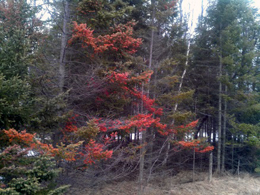Winter burn on trees more likely following harsh Michigan winter
Frozen ground combined with freezing winds and drying sun is causing “winter burn” to the foliage of conifer trees across many parts of Michigan. These negative weather-related impacts are most noticeable in open grown trees or along the state’s main roads
 Most needle-bearing trees, more commonly referred to as conifers, retain the majority of their foliage throughout the winter season. Their needle-shaped leaves are covered by a waxy coating. This wax coating helps protect the needles from harsh winter winds and retain moisture. The exception to this in Michigan is the tamarack species, a deciduous member of the Larch family that drops all of its needles each year.
Most needle-bearing trees, more commonly referred to as conifers, retain the majority of their foliage throughout the winter season. Their needle-shaped leaves are covered by a waxy coating. This wax coating helps protect the needles from harsh winter winds and retain moisture. The exception to this in Michigan is the tamarack species, a deciduous member of the Larch family that drops all of its needles each year.
Photo at right: Trees found recently on US-2 in eastern Delta County in Michigan. Photo courtesy of Mike Schira.
However, dry winter air driven by winds can evaporate moisture from needles in spite of the wax protection on its needles. When frozen, soil conditions prevent moisture replacement to the needles and affected foliage may discolor with the green needles turning red or orange. This condition is most commonly referred to as winter burn. This winter burn condition is most noticeable on the sunny south and west sides of conifer trees.
Open-grown trees, less protected from winter winds, are more likely to show this seasonal stress. Additionally, trees along main roads may show more damage from winter burn. Airborne chloride particles in road salt settle on needles and break down wax protection.
Healthy trees should be able to grow through this winter burn stress. Although heavily affected foliage will most likely die and be shed by the trees, the buds are usually unaffected and new growth should be evident in the spring growing season. This loss of needles does cause some stress, resulting in reduced growth in the affected years. Needles losing their waxy protection may also be less protected from harmful insects and disease.
Wind breaks or barriers, reducing exposure to airborne salt and maintaining snow cover around trees are all effective ways to help reduce the impacts of winter burn. A tree owner’s best defense against tree loss from winter climatic stresses is to maintain good tree health through good cultural practices such as watering and fertilization.
Michigan State University Extension Bookstore has several publications available with recommendations and suggestions for growing and maintaining healthy trees.



 Print
Print Email
Email



